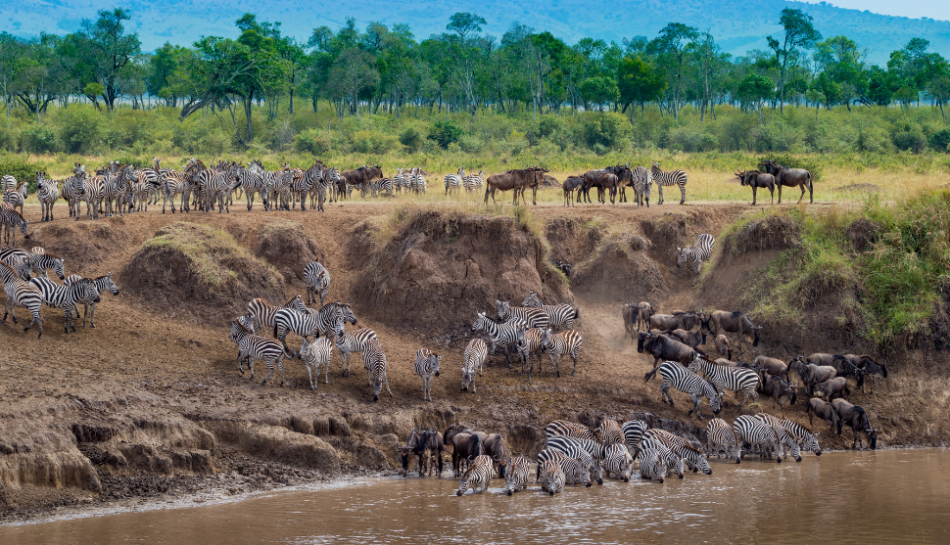When it comes to planning an African safari adventure, we are often met with the dilemma : Kenya or Tanzania? Both countries boast breathtaking landscapes, abundant wildlife, and a rich cultural tapestry. However, choosing between the two can be a nuanced decision, dependent on various factors. In this blog, we'll delve into the comparisons between Kenya and Tanzania, exploring their safari offerings, cultural nuances, and the best times to visit.
The Great Migration:
For many wildlife enthusiasts, the great migration is the pièce de résistance of an African safari. Kenya's Masai Mara is world-renowned for hosting this spectacular event, where millions of wildebeest and other herbivores traverse the savannah and cross the Mara River, in search of greener pastures. The sheer magnitude of the migration is a sight to behold, making Kenya a clear winner during this season. I think that no other world wonder beat the great Migration, the first time I witnessed it, my heart stopped. However, the story takes a different turn outside migration season. During other times of the year, Tanzania's Serengeti steals the spotlight. Despite being part of the same ecosystem as the Masai mara, the Serengeti side provides a more untouched, wild ambiance, with fewer crowds. The abundance of wildlife found in the Serengeti is simply unparalleled.
Crowds and Costs:
Kenya's allure lies not only in the awe-inspiring migration but also in its affordability and diverse accommodation options, compared to Tanzania. Kenya offers a range of choices, from budget-friendly lodges to luxury tented camps. However, this accessibility comes at a price – Kenya tends to attract a larger number of tourists, resulting in busier parks and more crowded sightings. On the flip side, Tanzania, while slightly pricier, offers a more authentic experience. The vast expanses of the Serengeti, especially on the Tanzanian side, provide a sense of untouched wilderness.
Safari Parks
Kenya boasts an impressive array of safari parks beyond the Masai Mara, offering diverse ecosystems and wildlife. This variety caters to different preferences, ensuring that visitors can explore various landscapes and encounter an abundance of wildlife. Tanzania, while having fewer safari parks overall, features the iconic Ngorongoro Crater, a UNESCO World Heritage Site. This natural amphitheatre is a unique ecosystem in itself, teeming with wildlife.
Cultural Differences:
The cultural differences between Kenya and Tanzania can be understood through various aspects, including language, cultural influences, and the social dynamics between locals and Western travelers.
Kenya: Kenya reflects a more Westernized influence, especially in urban areas. The presence of Western culture is evident in lifestyle choices, fashion, and entertainment. The influence of Western media and modern conveniences is more pronounced in Kenya, creating a blend of modern comforts with traditional charm.
Tanzania: Tanzania places a strong emphasis on preserving and celebrating its heritage, culture, traditions, and language. There is a concerted effort to maintain a connection with traditional values and practices. The cultural experience in Tanzania is often more immersive and authentic, with a focus on showcasing the richness of its history and traditions.
Language:
Kenya: English is widely spoken, particularly in urban areas. It is not uncommon to hear locals conversing in English, making it relatively easy for Western travelers to communicate.
Tanzania: Swahili is the dominant language in Tanzania. While English is also taught in schools, there might be more of a language barrier for Western travelers in Tanzania compared to Kenya. The prevalence of Swahili contributes to a distinctive linguistic and cultural identity.
Social Dynamics and Hospitality:
Kenya: Kenyans are known for their warmth and hospitality. As a Western traveler in Kenya, you may experience a more familiar and peer-like treatment. The interaction between locals and tourists may feel more relaxed and informal.
Tanzania: Tanzanians are described as humble and extremely respectful. Despite their welcoming nature, there might be a perceived gap or distance between Western travelers and locals. The respect and formality in social interactions could create a different dynamic compared to the more laid-back atmosphere in Kenya.
Communication and Authenticity:
Kenya: The ease of communication in English may contribute to a more straightforward interaction for Western travelers. The Western influence might make the experience feel more cosmopolitan and less traditional.
Tanzania: The struggle with English, as mentioned, can add authenticity to the Tanzanian experience. The effort to communicate in Swahili and the potential language barrier might enhance the sense of being in a place that is deeply rooted in its own cultural context.
In summary, while both Kenya and Tanzania offer rich cultural experiences, Kenya may appeal to those seeking a blend of modern and traditional influences, with a more relaxed social dynamic. Tanzania, on the other hand, provides a deeper immersion into its cultural heritage, with a focus on preserving traditions and a potentially more formal social interaction.
So, what’s the verdict, Tanzania or Kenya?
In the Kenya vs. Tanzania safari debate, the choice ultimately boils down to personal preferences and the timing of your visit. If witnessing the great migration is at the top of your bucket list, Kenya's Masai Mara is the place to be. However, for a more serene and culturally rich experience, especially outside migration season, Tanzania's Serengeti and Ngorongoro Crater steal the show. Both countries have their unique charm, ensuring an unforgettable safari adventure, tailored to your individual tastes.
Let us plan your next trip to East Africa. We'll take care of everything: https://www.goafricatour.com/contact



